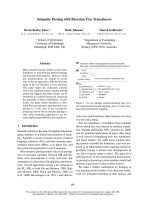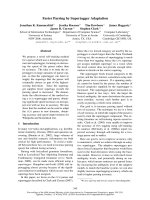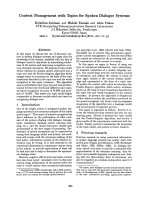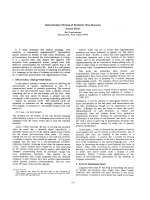Báo cáo khoa học: "Language-Independent Parsing with Empty Elements" docx
Bạn đang xem bản rút gọn của tài liệu. Xem và tải ngay bản đầy đủ của tài liệu tại đây (296.02 KB, 5 trang )
Proceedings of the 49th Annual Meeting of the Association for Computational Linguistics:shortpapers, pages 212–216,
Portland, Oregon, June 19-24, 2011.
c
2011 Association for Computational Linguistics
Language-Independent Parsing with Empty Elements
Shu Cai and David Chiang
USC Information Sciences Institute
4676 Admiralty Way, Suite 1001
Marina del Rey, CA 90292
{shucai,chiang}@isi.edu
Yoav Goldberg
Ben Gurion University of the Negev
Department of Computer Science
POB 653 Be’er Sheva, 84105, Israel
Abstract
We present a simple, language-independent
method for integrating recovery of empty ele-
ments into syntactic parsing. This method out-
performs the best published method we are
aware of on English and a recently published
method on Chinese.
1 Introduction
Empty elements in the syntactic analysis of a sen-
tence are markers that show where a word or phrase
might otherwise be expected to appear, but does not.
They play an important role in understanding the
grammatical relations in the sentence. For example,
in the tree of Figure 2a, the first empty element (*)
marks where John would be if believed were in the
active voice (someone believed. . .), and the second
empty element (*T*) marks where the man would be
if who were not fronted (John was believed to admire
who?).
Empty elements exist in many languages and serve
different purposes. In languages such as Chinese and
Korean, where subjects and objects can be dropped
to avoid duplication, empty elements are particularly
important, as they indicate the position of dropped
arguments. Figure 1 gives an example of a Chinese
parse tree with empty elements. The first empty el-
ement (*pro*) marks the subject of the whole sen-
tence, a pronoun inferable from context. The second
empty element (*PRO*) marks the subject of the de-
pendent VP (shíshī fǎlǜ tiáowén).
The Penn Treebanks (Marcus et al., 1993; Xue
et al., 2005) contain detailed annotations of empty
elements. Yet most parsing work based on these
resources has ignored empty elements, with some
IP.
VP.
VP.
IP.
VP.
NP.
NN.
条文
tiáowén
clause
.
NN.
法律
fǎlǜ
law
.
VV.
实施
shíshī
implement
.
NP.
NONE
*PRO*
.
VV.
终止
zhōngzhǐ
suspend
.
ADVP.
AD.
暂时
zànshí
for now
.
NP.
NONE
*pro*
Figure 1: Chinese parse tree with empty elements marked.
The meaning of the sentence is, “Implementation of the
law is temporarily suspended.”
notable exceptions. Johnson (2002) studied empty-
element recovery in English, followed by several
others (Dienes and Dubey, 2003; Campbell, 2004;
Gabbard et al., 2006); the best results we are aware of
are due to Schmid (2006). Recently, empty-element
recovery for Chinese has begun to receive attention:
Yang and Xue (2010) treat it as classification prob-
lem, while Chung and Gildea (2010) pursue several
approaches for both Korean and Chinese, and ex-
plore applications to machine translation.
Our intuition motivating this work is that empty
elements are an integral part of syntactic structure,
and should be constructed jointly with it, not added
in afterwards. Moreover, we expect empty-element
recovery to improve as the parsing quality improves.
Our method makes use of a strong syntactic model,
the PCFGs with latent annotation of Petrov et al.
(2006), which we extend to predict empty cate-
212
gories by the use of lattice parsing. The method
is language-independent and performs very well on
both languages we tested it on: for English, it out-
performs the best published method we are aware of
(Schmid, 2006), and for Chinese, it outperforms the
method of Yang and Xue (2010).
1
2 Method
Our method is fairly simple. We take a state-of-the-
art parsing model, the Berkeley parser (Petrov et al.,
2006), train it on data with explicit empty elements,
and test it on word lattices that can nondeterminis-
tically insert empty elements anywhere. The idea is
that the state-splitting of the parsing model will en-
able it to learn where to expect empty elements to be
inserted into the test sentences.
Tree transformations Prior to training, we alter
the annotation of empty elements so that the termi-
nal label is a consistent symbol (ϵ), the preterminal
label is the type of the empty element, and -NONE-
is deleted (see Figure 2b). This simplifies the lat-
tices because there is only one empty symbol, and
helps the parsing model to learn dependencies be-
tween nonterminal labels and empty-category types
because there is no intervening -NONE
Then, following Schmid (2006), if a constituent
contains an empty element that is linked to another
node with label X, then we append /X to its label.
If there is more than one empty element, we pro-
cess them bottom-up (see Figure 2b). This helps the
parser learn to expect where to find empty elements.
In our experiments, we did this only for elements of
type *T*. Finally, we train the Berkeley parser on the
preprocessed training data.
Lattice parsing Unlike the training data, the test
data does not mark any empty elements. We allow
the parser to produce empty elements by means of
lattice-parsing (Chappelier et al., 1999), a general-
ization of CKY parsing allowing it to parse a word-
lattice instead of a predetermined list of terminals.
Lattice parsing adds a layer of flexibility to exist-
ing parsing technology, and allows parsing in sit-
uations where the yield of the tree is not known
in advance. Lattice parsing originated in the speech
1
Unfortunately, not enough information was available to
carry out comparison with the method of Chung and Gildea
(2010).
processing community (Hall, 2005; Chappelier et
al., 1999), and was recently applied to the task
of joint clitic-segmentation and syntactic-parsing in
Hebrew (Goldberg and Tsarfaty, 2008; Goldberg
and Elhadad, 2011) and Arabic (Green and Man-
ning, 2010). Here, we use lattice parsing for empty-
element recovery.
We use a modified version of the Berkeley parser
which allows handling lattices as input.
2
The modifi-
cation is fairly straightforward: Each lattice arc cor-
respond to a lexical item. Lexical items are now in-
dexed by their start and end states rather than by
their sentence position, and the initialization proce-
dure of the CKY chart is changed to allow lexical
items of spans greater than 1. We then make the nec-
essary adjustments to the parsing algorithm to sup-
port this change: trying rules involving preterminals
even when the span is greater than 1, and not relying
on span size for identifying lexical items.
At test time, we first construct a lattice for each
test sentence that allows 0, 1, or 2 empty symbols
(ϵ) between each pair of words or at the start/end of
the sentence. Then we feed these lattices through our
lattice parser to produce trees with empty elements.
Finally, we reverse the transformations that had been
applied to the training data.
3 Evaluation Measures
Evaluation metrics for empty-element recovery are
not well established, and previous studies use a vari-
ety of metrics. We review several of these here and
additionally propose a unified evaluation of parsing
and empty-element recovery.
3
If A and B are multisets, let A(x) be the number
of occurrences of x in A, let |A| =
∑
x
A(x), and
let A ∩ B be the multiset such that (A ∩ B)(x) =
min(A(x), B(x)). If T is the multiset of “items” in the
trees being tested and G is the multiset of “items” in
the gold-standard trees, then
precision =
|G ∩ T|
|T|
recall =
|G ∩ T|
|G|
F
1
=
2
1
precision
+
1
recall
2
The modified parser is available at .
ac.il/~yoavg/software/blatt/
3
We provide a scoring script which supports all of these eval-
uation metrics. The code is available at />~chiang/software/eevalb.py .
213
SBARQ.
SQ.
VP.
S.
VP.
VP.
NP.
NONE
*T*
.
VB.
admire
.
TO.
to
.
NP.
NONE
*
.
VBN.
believed
.
NP.
NNP.
John
.
VBZ.
is
.
WHNP.
WP.
who
SBARQ.
SQ/WHNP.
VP/WHNP/NP.
S/WHNP/NP.
VP/WHNP.
VP/WHNP.
NP/WHNP.
*T*.
ϵ
.
VB.
admire
.
TO.
to
.
NP.
*.
ϵ
.
VBN.
believed
.
NP.
NNP.
John
.
VBZ.
is
.
WHNP.
WP.
who
(a) (b)
Figure 2: English parse tree with empty elements marked. (a) As annotated in the Penn Treebank. (b) With empty
elements reconfigured and slash categories added.
where “items” are defined differently for each met-
ric, as follows. Define a nonterminal node, for
present purposes, to be a node which is neither a ter-
minal nor preterminal node.
The standard PARSEVAL metric (Black et al.,
1991) counts labeled nonempty brackets: items are
(X, i, j) for each nonempty nonterminal node, where
X is its label and i, j are the start and end positions
of its span.
Yang and Xue (2010) simply count unlabeled
empty elements: items are (i, i) for each empty ele-
ment, where i is its position. If multiple empty ele-
ments occur at the same position, they only count the
last one.
The metric originally proposed by Johnson (2002)
counts labeled empty brackets: items are ( X/t, i, i)for
each empty nonterminal node, where X is its label
and t is the type of the empty element it dominates,
but also (t, i, i ) for each empty element not domi-
nated by an empty nonterminal node.
4
The following
structure has an empty nonterminal dominating two
empty elements:
SBAR.
S.
NONE
*T*
.
NONE
0
Johnson counts this as (SBAR, i, i), (S/*T*, i, i);
Schmid (2006) counts it as a single
4
This happens in the Penn Treebank for types *U* and 0, but
never in the Penn Chinese Treebank except by mistake.
(SBAR-S/*T*, i, i).
5
We tried to follow Schmid
in a generic way: we collapse any vertical chain of
empty nonterminals into a single nonterminal.
In order to avoid problems associated with cases
like this, we suggest a pair of simpler metrics. The
first is to count labeled empty elements, i.e., items
are (t, i, i) for each empty element, and the second,
similar in spirit to SParseval (Roark et al., 2006), is
to count all labeled brackets, i.e., items are (X, i, j )
for each nonterminal node (whether nonempty or
empty). These two metrics, together with part-of-
speech accuracy, cover all possible nodes in the tree.
4 Experiments and Results
English As is standard, we trained the parser on
sections 02–21 of the Penn Treebank Wall Street
Journal corpus, used section 00 for development, and
section 23 for testing. We ran 6 cycles of training;
then, because we were unable to complete the 7th
split-merge cycle with the default setting of merg-
ing 50% of splits, we tried increasing merges to 75%
and ran 7 cycles of training. Table 1 presents our
results. We chose the parser settings that gave the
best labeled empty elements F
1
on the dev set, and
used these settings for the test set. We outperform the
state of the art at recovering empty elements, as well
as achieving state of the art accuracy at recovering
phrase structure.
5
This difference is not small; scores using Schmid’s metric
are lower by roughly 1%. There are other minor differences in
Schmid’s metric which we do not detail here.
214
Labeled Labeled All Labeled
Empty Brackets Empty Elements Brackets
Section System P R F
1
P R F
1
P R F
1
00 Schmid (2006) 88.3 82.9 85.5 89.4 83.8 86.5 87.1 85.6 86.3
split 5× merge 50% 91.0 79.8 85.0 93.1 81.8 87.1 90.4 88.7 89.5
split 6× merge 50% 91.9 81.1 86.1 93.6 82.4 87.6 90.4 89.1 89.7
split 6× merge 75% 92.7 80.7 86.3 94.6 82.0 87.9 90.3 88.5 89.3
split 7× merge 75% 91.0 80.4 85.4 93.2 82.1 87.3 90.5 88.9 89.7
23 Schmid (2006) 86.1 81.7 83.8 87.9 83.0 85.4 86.8 85.9 86.4
split 6× merge 75% 90.1 79.5 84.5 92.3 80.9 86.2 90.1 88.5 89.3
Table 1: Results on Penn (English) Treebank, Wall Street Journal, sentences with 100 words or fewer.
Unlabeled Labeled All Labeled
Empty Elements Empty Elements Brackets
Task System P R F
1
P R F
1
P R F
1
Dev split 5× merge 50% 82.5 58.0 68.1 72.6 51.8 60.5 84.6 80.7 82.6
split 6× merge 50% 76.4 60.5 67.5 68.2 55.1 60.9 83.2 81.3 82.2
split 7× merge 50% 74.9 58.7 65.8 65.9 52.5 58.5 82.7 81.1 81.9
Test Yang and Xue (2010) 80.3 57.9 63.2
split 6× merge 50% 74.0 61.3 67.0 66.0 54.5 58.6 82.7 80.8 81.7
Table 2: Results on Penn (Chinese) Treebank.
Chinese We also experimented on a subset of
the Penn Chinese Treebank 6.0. For comparabil-
ity with previous work (Yang and Xue, 2010),
we trained the parser on sections 0081–0900, used
sections 0041–0080 for development, and sections
0001–0040 and 0901–0931 for testing. The results
are shown in Table 2. We selected the 6th split-merge
cycle based on the labeled empty elements F
1
mea-
sure. The unlabeled empty elements column shows
that our system outperforms the baseline system of
Yang and Xue (2010). We also analyzed the empty-
element recall by type (Table 3). Our system outper-
formed that of Yang and Xue (2010) especially on
*pro*, used for dropped arguments, and *T*, used
for relative clauses and topicalization.
5 Discussion and Future Work
The empty-element recovery method we have
presented is simple, highly effective, and fully
integrated with state of the art parsing. We hope
to exploit cross-lingual information about empty
elements in machine translation. Chung and
Gildea (2010) have shown that such information
indeed helps translation, and we plan to extend this
work by handling more empty categories (rather
Total Correct Recall
Type Gold YX Ours YX Ours
*pro* 290 125 159 43.1 54.8
*PRO* 299 196 199 65.6 66.6
*T* 578 338 388 58.5 67.1
*RNR* 32 20 15 62.5 46.9
*OP* 134 20 65 14.9 48.5
* 19 5 3 26.3 15.8
Table 3: Recall on different types of empty categories.
YX = (Yang and Xue, 2010), Ours = split 6×.
than just *pro* and *PRO*), and to incorporate them
into a syntax-based translation model instead of a
phrase-based model.
We also plan to extend our work here to recover
coindexation information (links between a moved el-
ement and the trace which marks the position it was
moved from). As a step towards shallow semantic
analysis, this may further benefit other natural lan-
guage processing tasks such as machine translation
and summary generation.
Acknowledgements
We would like to thank Slav Petrov for his help in
running the Berkeley parser, and Yaqin Yang, Bert
215
Xue, Tagyoung Chung, and Dan Gildea for their an-
swering our many questions. We would also like
to thank our colleagues in the Natural Language
Group at ISI for meaningful discussions and the
anonymous reviewers for their thoughtful sugges-
tions. This work was supported in part by DARPA
under contracts HR0011-06-C-0022 (subcontract to
BBN Technologies) and DOI-NBC N10AP20031,
and by NSF under contract IIS-0908532.
References
E. Black, S. Abney, D. Flickinger, C. Gdaniec, R. Gr-
ishman, P. Harrison, D. Hindle, R. Ingria, F. Jelinek,
J. Klavans, M. Liberman, M. Marcus, S. Roukos,
B. Santorini, and T. Strzalkowski. 1991. A procedure
for quantitatively comparing the syntactic coverage of
English grammars. In Proc. DARPA Speech and Natu-
ral Language Workshop.
Richard Campbell. 2004. Using linguistic principles to
recover empty categories. In Proc. ACL.
J C. Chappelier, M. Rajman, R. Arag
¨
ues, and A. Rozen-
knop. 1999. Lattice parsing for speech recognition.
In Proc. Traitement Automatique du Langage Naturel
(TALN).
Tagyoung Chung and Daniel Gildea. 2010. Effects
of empty categories on machine translation. In Proc.
EMNLP.
P
´
eter Dienes and Amit Dubey. 2003. Antecedent recov-
ery: Experiments with a trace tagger. In Proc. EMNLP.
Ryan Gabbard, Seth Kulick, and Mitchell Marcus. 2006.
Fully parsing the Penn Treebank. In Proc. NAACL
HLT.
Yoav Goldberg and Michael Elhadad. 2011. Joint He-
brew segmentation and parsing using a PCFG-LA lat-
tice parser. In Proc. of ACL.
Yoav Goldberg and Reut Tsarfaty. 2008. A single gener-
ative model for joint morphological segmentation and
syntactic parsing. In Proc. of ACL.
Spence Green and Christopher D. Manning. 2010. Better
Arabic parsing: Baselines, evaluations, and analysis. In
Proc of COLING-2010.
Keith B. Hall. 2005. Best-first word-lattice parsing:
techniques for integrated syntactic language modeling.
Ph.D. thesis, Brown University, Providence, RI, USA.
Mark Johnson. 2002. A simple pattern-matching al-
gorithm for recovering empty nodes and their an-
tecedents. In Proc. ACL.
Mitchell P. Marcus, Beatrice Santorini, and Mary Ann
Marcinkiewicz. 1993. Building a large annotated cor-
pus of English: the Penn Treebank. Computational
Linguistics, 19:313–330.
Slav Petrov, Leon Barrett, Romain Thibaux, and Dan
Klein. 2006. Learning accurate, compact, and inter-
pretable tree annotation. In Proc. COLING-ACL.
Brian Roark, Mary Harper, Eugene Charniak, Bonnie
Dorr, Mark Johnson, Jeremy G. Kahn, Yang Liu, Mari
Ostendorf, John Hale, Anna Krasnyanskaya, Matthew
Lease, Izhak Shafran, Matthew Snover, Robin Stewart,
and Lisa Yung. 2006. SParseval: Evaluation metrics
for parsing speech. In Proc. LREC.
Helmut Schmid. 2006. Trace prediction and recovery
with unlexicalized PCFGs and slash features. In Proc.
COLING-ACL.
Nianwen Xue, Fei Xia, Fu-dong Chiou, and Martha
Palmer. 2005. The Penn Chinese TreeBank: Phrase
structure annotation of a large corpus. Natural Lan-
guage Engineering, 11(2):207–238.
Yaqin Yang and Nianwen Xue. 2010. Chasing the ghost:
recovering empty categories in the Chinese Treebank.
In Proc. COLING.
216









